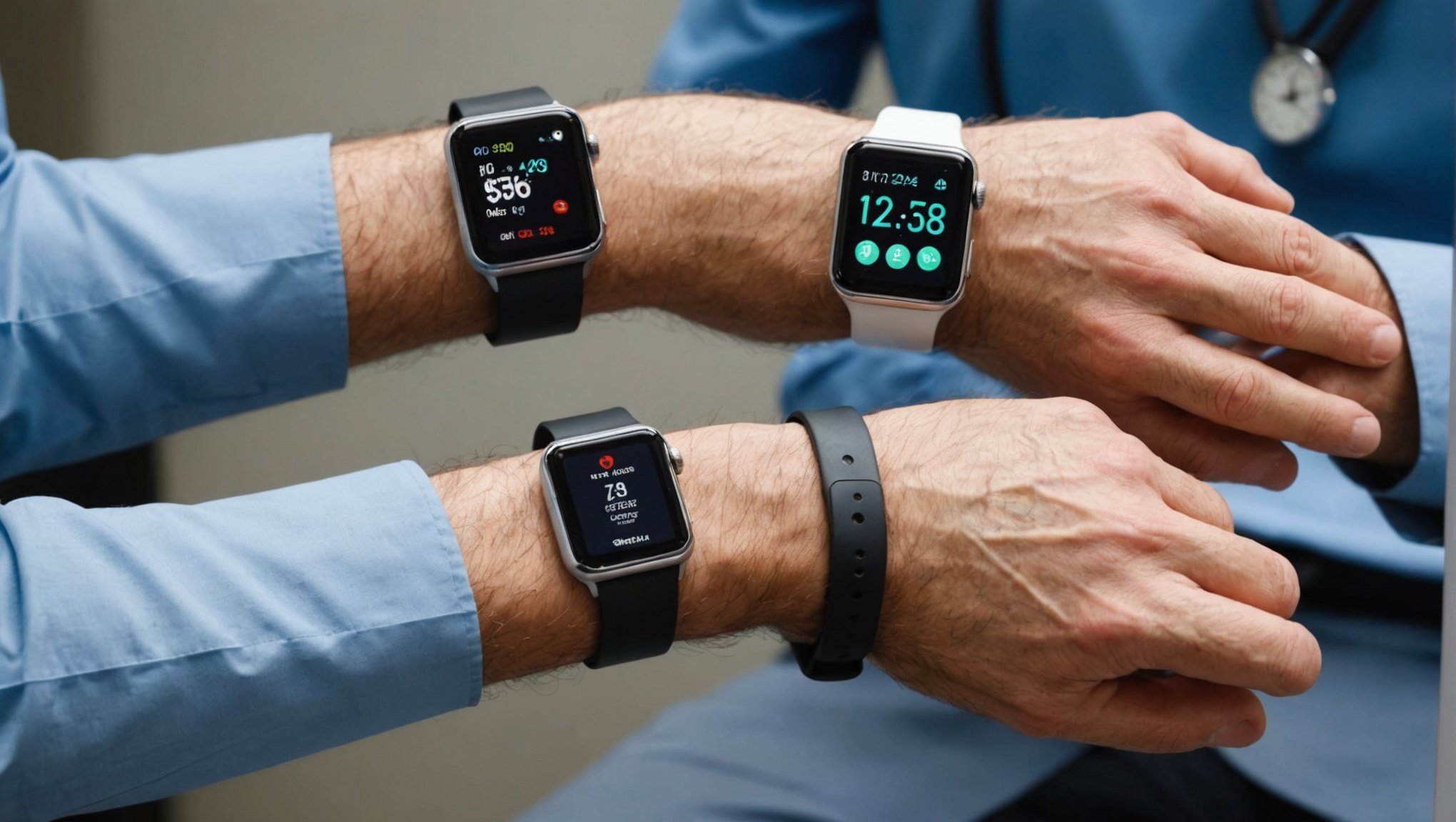Transforming Healthcare: The Impact of Wearable Technology on Patient Monitoring in the UK
The Rise of Wearable Technology in Healthcare
In the UK, the healthcare landscape is undergoing a significant transformation, driven in large part by the advent of wearable technology. Devices such as smartwatches, fitness trackers, and specialized health monitoring wearables are revolutionizing how patients understand and manage their health. This shift is not just about tracking steps or heart rates; it’s about empowering patients with real-time data that can prevent illnesses, improve treatment outcomes, and reduce the burden on the National Health Service (NHS).
Remote Patient Monitoring (RPM)
One of the most compelling aspects of wearable technology is its ability to enable remote patient monitoring. For patients with chronic conditions like diabetes or heart disease, wearable devices can continuously collect vital data such as blood pressure, glucose levels, and heart rate. This data is then transmitted to healthcare providers, allowing them to monitor patients in real-time and respond quickly to any anomalies. This approach minimizes the need for hospital visits and provides patients with a greater sense of independence and control over their health[3].
This might interest you : Exploring the Influence of Microsatellite Technology on Maritime Surveillance in the UK
The NHS’s 10-Year Health Plan
At the heart of this transformation is the NHS’s ambitious 10-year health plan, spearheaded by Health Secretary Wes Streeting. This plan aims to revolutionize the NHS by leveraging cutting-edge technology to create a more community-led and patient-centric healthcare system.
Community-Led Health Treatment
The plan involves rolling out smartwatches and other wearable devices to millions of people, particularly those with debilitating conditions. These devices will track blood pressure, glucose spikes, and even monitor how cancer patients are responding to treatment. The goal is to prevent ill-health and treat more patients at home, reducing the strain on overstretched hospitals. Streeting emphasized, “Our 10-year health plan will turn the NHS on its head – transforming it into a Neighbourhood Health Service powered by cutting-edge technology that helps us stay healthy and out of hospital”[2][5].
Also to discover : Exploring the Economic Effects of Renewable Energy Subsidies on the UK”s Financial Landscape
Preventative Care and Early Intervention
Wearable technology is also transforming preventative care by making it more proactive. Devices can alert users to changes in their health, such as irregular heartbeats or abnormal blood pressure, prompting them to seek medical advice before a condition worsens. For example, smartwatches can detect atrial fibrillation, a common heart condition that can lead to stroke, allowing for early intervention and potentially saving lives[3].
Benefits for Patients and Healthcare Providers
The integration of wearable technology into healthcare offers numerous benefits for both patients and healthcare providers.
Improved Patient Outcomes
- Personalized Care: Wearable devices provide healthcare workers with real-time data, enabling more personalized and efficient care. This leads to better patient outcomes, quicker recovery times, and higher patient satisfaction[3].
- Enhanced Independence: Patients can monitor their health from the comfort of their homes, reducing the need for frequent hospital visits and giving them a greater sense of independence.
- Early Detection: Wearables can detect health anomalies early, allowing for prompt medical intervention and potentially preventing severe health crises.
Streamlined Operations
- Automated Tasks: The integration of AI and wearable technology can automate tasks like record-keeping, scheduling, and patient monitoring, reducing the administrative burden on healthcare staff. This allows healthcare workers to focus more on patient care and less on paperwork[3].
- Reduced Workload: By taking on routine and physically demanding tasks, technology can help reduce burnout and physical strain among healthcare workers, improving worker satisfaction and retention.
Challenges and Considerations
While the potential of wearable technology in healthcare is vast, there are several challenges and considerations that need to be addressed.
Funding and Investment
The successful implementation of these reforms requires significant investment. Saffron Cordery, deputy chief executive of NHS Providers, highlighted the need for sustainable funding and investment, particularly for capital and workforce development, to deliver the government’s plan effectively[2].
Workforce Shortages
Nicola Ranger, general secretary of the Royal College of Nursing, pointed out that the NHS “simply does not have the nursing numbers to deliver” the proposed changes. She emphasized the need for new investment to address chronic workforce shortages and the undervaluation of nursing staff[2].
Data Privacy and Security
As wearable devices collect and transmit sensitive health data, ensuring data privacy and security is crucial. Healthcare providers must implement robust measures to protect patient data and maintain trust in the system.
Practical Insights and Actionable Advice
For those considering the use of wearable technology for health monitoring, here are some practical insights and actionable advice:
Choosing the Right Device
- Functionality: Select a device that meets your specific health monitoring needs. For example, if you have diabetes, look for a device that tracks glucose levels.
- User-Friendliness: Opt for a device with an intuitive interface to ensure ease of use.
- Compatibility: Ensure the device is compatible with your smartphone or other health monitoring systems.
Integrating Wearable Data into Healthcare
- Consult Your Doctor: Before starting to use a wearable device, consult with your healthcare provider to understand how the data can be integrated into your care plan.
- Regular Monitoring: Regularly review the data from your wearable device with your healthcare provider to make informed decisions about your health.
Maintaining Data Security
- Use Secure Connections: Ensure that the data transmission from your wearable device to your healthcare provider is secure.
- Update Software Regularly: Keep the software of your wearable device and associated apps up to date to protect against security vulnerabilities.
Examples and Anecdotes
Real-Life Impact
One compelling example of the impact of wearable technology is the story of a patient with atrial fibrillation who was detected by his smartwatch. The device alerted him to an irregular heartbeat, prompting him to seek immediate medical attention. This early detection prevented a potential stroke, highlighting the life-saving potential of these devices.
Community Engagement
The NHS’s plan to engage in a “national conversation” about the future of healthcare is a significant step. By involving patients and staff in shaping major reforms, the NHS can ensure that the changes are patient-centric and meet the real needs of the community. This approach has been successful in other areas, such as the integration of telemedicine services, which have expanded care models and improved patient access to healthcare[2].
The integration of wearable technology into healthcare is a transformative step that holds immense promise for improving patient care, streamlining healthcare operations, and reducing costs. As the UK embarks on this 10-year health plan, it is crucial to address the challenges and ensure that the benefits are realized. With the right investment, workforce support, and focus on patient needs, wearable technology can indeed revolutionize the NHS and make it fit for the future.
Detailed Bullet Point List: Benefits of Wearable Technology in Healthcare
- Real-Time Monitoring: Continuous tracking of vital signs and health metrics.
- Early Detection: Early alert to health anomalies, allowing for prompt medical intervention.
- Personalized Care: Real-time data enables more personalized and efficient care.
- Enhanced Independence: Patients can monitor their health from home, reducing hospital visits.
- Streamlined Operations: Automation of administrative tasks reduces the workload on healthcare staff.
- Improved Patient Outcomes: Better patient outcomes, quicker recovery times, and higher patient satisfaction.
- Support for Healthcare Workers: Reduced burnout and physical strain, improving worker satisfaction and retention.
- Expanded Care Models: Telemedicine and remote monitoring open up new care models, serving more patients with fewer resources.
Comprehensive Table: Comparison of Wearable Devices for Health Monitoring
| Device | Key Features | Health Metrics Tracked | Compatibility | User-Friendliness |
|---|---|---|---|---|
| Apple Watch | ECG, Heart Rate, Blood Oxygen | Heart Rate, Blood Oxygen, ECG | iOS | High |
| Fitbit Sense | ECG, Heart Rate, Skin Temperature | Heart Rate, Skin Temperature, ECG | Android, iOS | High |
| Oura Ring | Heart Rate, Sleep Tracking, Body Temperature | Heart Rate, Sleep Quality, Body Temperature | Android, iOS | High |
| Samsung Galaxy Watch | ECG, Heart Rate, Blood Pressure | Heart Rate, Blood Pressure, ECG | Android, iOS | Medium |
| Garmin Venu | Heart Rate, Blood Oxygen, Sleep Tracking | Heart Rate, Blood Oxygen, Sleep Quality | Android, iOS | Medium |
Quotes from Key Figures
- Wes Streeting, Health Secretary: “Our 10-year health plan will turn the NHS on its head – transforming it into a Neighbourhood Health Service powered by cutting-edge technology that helps us stay healthy and out of hospital.”[2]
- Nicola Ranger, General Secretary of the Royal College of Nursing: “Without new investment, the number of community nurses will stay on track to be half what it was two decades ago…. Nursing staff are ready to help deliver the modernisation our health service needs, but staff are overworked and chronically undervalued.”[2]
- Saffron Cordery, Deputy Chief Executive of NHS Providers: “Trust leaders will work with the government to get to grips with the challenges facing health and social care and to deliver improvements. However, this must go hand-in-hand with sustainable funding and investment, particularly for capital, an end to chronic workforce shortages and more support to meet growing demand.”[2]






